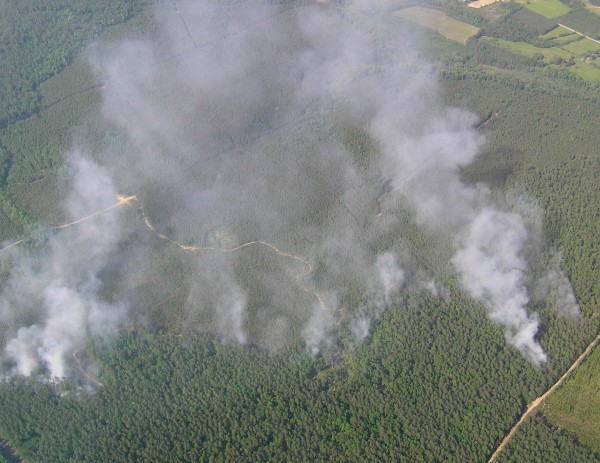Enhancing pine landscape suitability for forest / early successional birds
The Avian Heritage of Virginia and Washington D.C.
October 4, 2008Peregrine tracking project continues to produce new info
October 6, 2008
Written by Michael Wilson
October 5, 2008
Over the past two to three decades, timber managers began to implement intensive operations to produce sustained yield of plantation pines. The area of pine plantations rapidly grew to cover over 32 million acres in the southern United States during this time. Although specific techniques of pine plantation management vary with forest yield, clear cutting densely stocked stands on relatively short rotation schedules has become the dominant practice. This “grow them thick and cut them quick” tactic creates a specific age-class distribution of habitats that differs greatly from natural landscapes and truncates development of characteristics associated with old-growth forests.

Pine stand within southeastern Virginia. Low stem density achieved through low stocking rates or commercial thinning is the key to providing habitat to several species within the plantation context. Photo by Dana Bradshaw.
Pine plantations go through several stages of succession following planting. As the plantation matures, young pine trees form a dense, low canopy within 7 years that results in the decline of understory vegetation, along with the diversity and density of associated bird populations. Within the framework of traditional pulp production, canopy closure would be maintained until clear-cut harvest when the plantation is 20-25 years old. These silvicultural practices remove these lands from “bird production” for fully 2/3 of the harvest cycle. The lack of understory and wildlife supported by traditional silvicultural practices has lead to the “ecological desert” label commonly associated with pine plantations.
However, the recent use of more progressive silvicultural strategies has proven that production of wood products and wildlife habitat need not be mutually exclusive goals. By manipulating initial stocking level and by instituting mid-rotational thinning, the understory may be maintained for a much longer portion of the harvest cycle. This strategy makes managed forest lands both economically profitable and available as nesting habitat to many declining bird species.

Controlled burn within pine plantation in southeastern Virginia. Fire is an important management tool to maintain species composition in the southeastern pine ecosystem. Photo by Bryan Watts.
With the cooperation and support of the U. S. Department of Defense (DoD) Legacy Resource Management Program, researchers at the Center for Conservation Biology (CCB) are working to examine the relationships between stand age, pine stocking density, canopy closure, understory condition, and breeding birds within pine plantations to make recommendations on how silvicultural practices may be revised to enhance the habitat value of managed forests within the Mid-Atlantic and South Atlantic Regions.

The yellow-breasted chat is one of the species that benefits from active management of pine plantations. Photo by Dana Bradshaw.
In 2002, CCB completed a habitat assessment of public lands (e.g., DoD installations, National Wildlife Refuges, National Parks) within the mid-Atlantic region to evaluate their potential to support landbird conservation objectives. We identified and mapped 127,660 ha. (315,320 acres) of pine plantation across public lands that accounted for nearly 10% of all upland bird habitat on these properties. Many plantations exist in a state of low bird production due to prevailing management. Orchestrating wide ranging shifts in forest management on these patches will produce significant improvements on regional bird-landscape compatibility. For instance, early calculations from this project show that using new practices in pine plantations on public lands can produce an additional 21,000 pairs of northern bobwhites, 95,000 gray catbirds, 95,000 yellow-breasted chats, 74,000 brown-headed nuthatches, and 28,000 wood thrushes.



